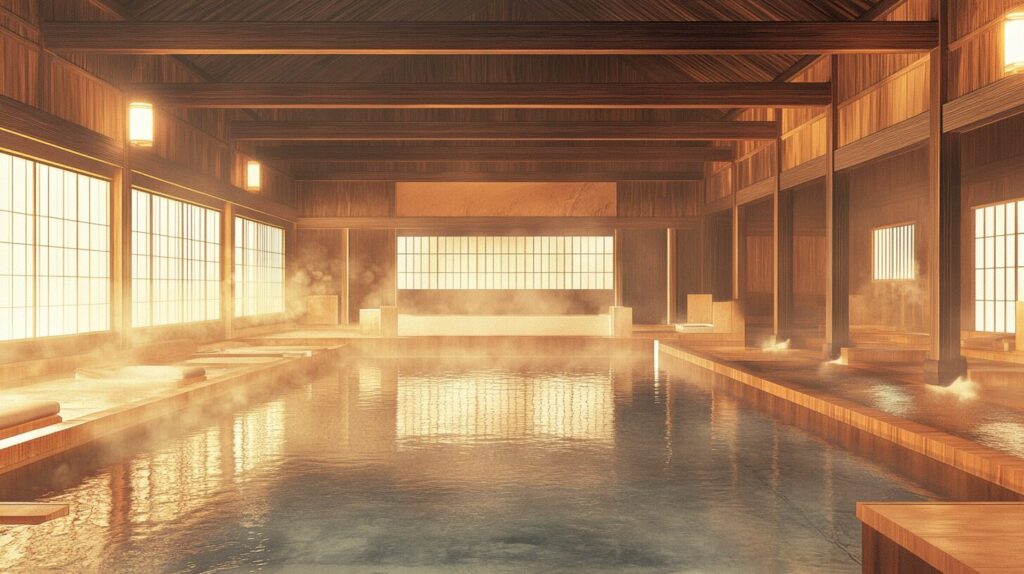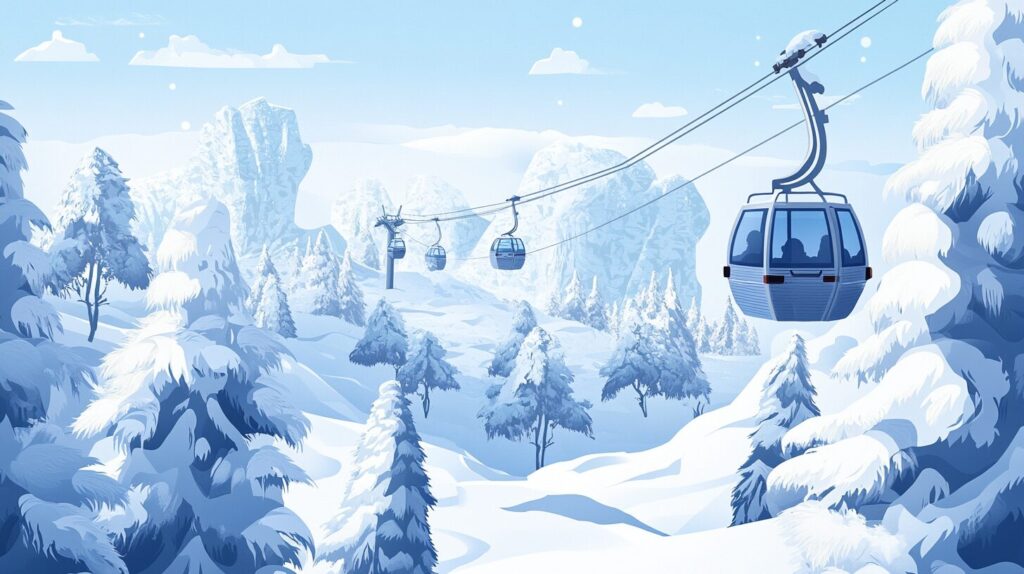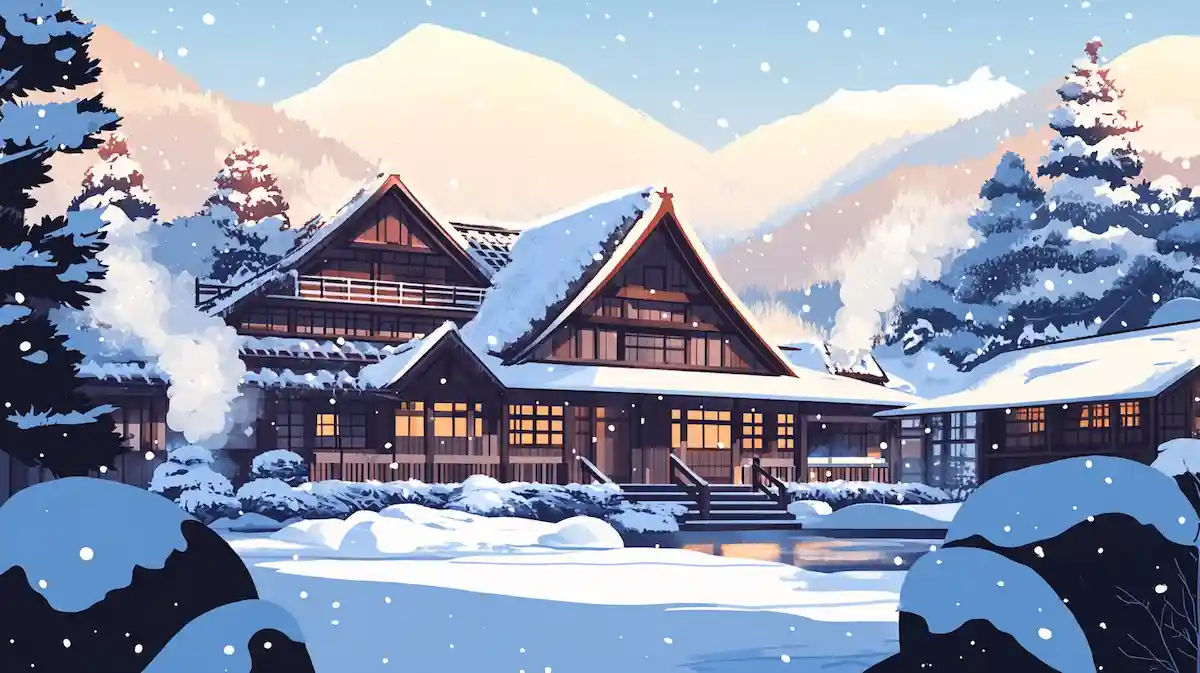酸ヶ湯温泉を英語で説明・紹介するための基本情報と、英会話に役立つ表現をシンプルでわかりやすい英語で紹介します。
英会話ダイアローグ・概要・10の質問を通して、酸ヶ湯温泉に関する英語表現を学びます。
英語
英会話ダイアローグを読む前に知っておくと良い前提知識と情報です。
- 場所とアクセス
- 酸ヶ湯温泉は青森県の八甲田山中腹、標高約900メートルに位置
- 新青森駅からバスで約1時間10分でアクセス可能
- 豪雪地帯にあり、冬季はアクセスが制限される場合がある
- 千人風呂について
- 「千人風呂」は酸ヶ湯温泉の大浴場で、約330平方メートルの広さ
- 青森ヒバ材を使用した伝統的な造りで、木の香りが特徴
- 基本的に混浴ですが、女性専用の時間帯も設けられている
- 温泉の特徴
- 酸性硫黄泉(pH約2.0)の白濁したお湯が特徴
- リウマチや神経痛、皮膚病などに効能があるとされている
- 「湯治」と呼ばれる療養目的の長期滞在が伝統的に行われてきた
- 季節の見どころ
- 冬季は周辺一帯が雪に覆われ、幻想的な雪景色を楽しめる
- 八甲田山の樹氷(Snow Monsters)は国際的にも有名な観光資源
- 八甲田ロープウェイから樹氷を見ることができる
2人が青森県の酸ヶ湯温泉について話しています。
日本最大級のヒバ千人風呂、強酸性の温泉の特徴、冬の風景(特に樹氷)、郷土料理、アクセス方法などを話題にしています。
会話 / dialogue

Hey Key, have you ever heard of Sukayu Onsen? I was reading about it the other day, and it sounds fascinating.

Oh, absolutely! Sukayu Onsen is one of Japan’s most famous hot springs. It’s in the Hakkoda Mountains in Aomori. Are you thinking of visiting?

Yeah, I’m really interested! I read that it has a huge mixed-gender bath called “Hiba Sen’nin Buro.” What’s so special about it?

That bath is legendary! It’s about 160 tatami mats in size, making it one of the biggest hot spring baths in Japan. Plus, it’s made entirely of Hiba wood, which gives it a natural, relaxing scent.

That sounds amazing! But mixed-gender? Isn’t that unusual in Japan?

It is, but Sukayu Onsen has a special tradition. There’s also a women-only time, but the schedule can change depending on the season. If you’re planning to go, it’s best to check their official website for the latest information.

That’s good to know. I also read that the hot spring water there is really acidic. What does that mean?

Yeah, it’s actually one of the most acidic in Japan! The water is around pH 2, depending on the specific spring source. That means it has strong antibacterial effects and is said to help with skin conditions, nerve pain, and joint pain.

Wow, that sounds intense! Will it hurt my skin?

If you have sensitive skin, you might feel a slight tingling sensation, but it depends on the person. Some people say it’s refreshing, while others find it a little strong.

That makes sense. By the way, I love winter scenery. Do you think it’s a good place to visit in winter?

Oh, for sure! In winter, Sukayu Onsen is covered in deep snow, and you can enjoy a snowy outdoor bath. The whole area gets about 10 meters of snowfall per year, making it one of Japan’s snowiest places.

Wow, 10 meters? That’s incredible! I also heard about something called the “Snow Monsters.” What are they?

Those are frozen trees covered in thick layers of snow and ice. You can see them on the nearby Hakkoda Mountains, especially if you take the Hakkoda Ropeway. But keep in mind, the Snow Monsters need specific weather conditions to form, so their appearance can change each year.

That sounds like a dream! What about food? Are there any special local dishes I should try?

Yes! You should try “Shoga Miso Oden” (Ginger Miso Oden), a local specialty. And of course, Aomori is famous for apples, so you should definitely have some fresh apple juice or even apple-based desserts.

That sounds delicious! How do I get there from Tokyo?

It’s actually pretty easy. Just take the Shinkansen to Shin-Aomori Station, and then a bus to Sukayu Onsen, which takes about 1 hour and 10 minutes. But keep in mind that in winter, heavy snowfall can affect the bus schedule, so it’s best to check the latest updates before you go.

That’s good advice. By the way, you mentioned “Toji” before. What exactly is that?

Good question! Toji is a traditional hot spring healing practice where people stay at an onsen for several days or even weeks to recover from fatigue, joint pain, or other health conditions. Sukayu Onsen is famous for this, and they even have self-catering rooms for long-term visitors.

That’s really interesting. I love the idea of soaking in a natural hot spring, surrounded by snow.

You’d love it. It’s a mix of relaxation, adventure, and cultural experience. You should definitely go!

You’ve convinced me! I’m going to start planning my trip. Thanks for all the info, Key!

No problem! Let me know if you need more tips. Enjoy your trip to Sukayu Onsen!
概要 / Overview
「酸ヶ湯温泉」について、理解を深めるための「英語での概要」です。
酸ヶ湯温泉

Location and History
Sukayu Onsen is a famous hot spring in the Hakkoda Mountains of Aomori, Japan. It has a history of over 300 years and is well known for its healing waters. In 1954, it became Japan’s first “National Health Resort Onsen” because of its strong healing properties. Many people visit Sukayu Onsen to relax and recover.
Hiba Sen’nin Buro: A Unique Bath
One of the most special things about Sukayu Onsen is the Hiba Sen’nin Buro, a huge mixed-gender bath. It is made of Hiba wood, which gives a natural and relaxing smell. The bath is 160 tatami mats in size, making it one of the largest hot spring baths in Japan. There is also a women-only time, so female visitors can enjoy it comfortably.
Acidic Hot Spring Water
Sukayu Onsen’s water is very acidic, with a pH level of around 2. This makes it one of the most acidic hot springs in Japan. The water is said to be good for the skin, nerve pain, and joint pain. Some people feel a tingling sensation, especially if they have sensitive skin.
Winter and the “Snow Monsters”
Sukayu Onsen is located in one of Japan’s snowiest areas. It receives over 10 meters of snow every year. In winter, visitors can enjoy a beautiful snowy outdoor bath. Nearby, people can also see the “Snow Monsters,” which are frozen trees covered in thick snow.
How to Get There
From Tokyo, take the Shinkansen to Shin-Aomori Station. Then, take a bus for about 1 hour and 10 minutes. In winter, heavy snowfall may affect buses, so it’s best to check travel conditions before visiting.
Conclusion
Sukayu Onsen is a great place to experience traditional Japanese hot springs and enjoy beautiful nature in all seasons!
10の質問 / 10 questions
「酸ヶ湯温泉」について、理解を深めるための「英語での10の質問」です。
1: What is Sukayu Onsen?
Sukayu Onsen is a famous hot spring located in the Hakkoda Mountains in Aomori, Japan. It is known for its highly acidic water and healing properties.
2: What is special about Sukayu Onsen’s water?
The water is very acidic, with a pH level of around 2. It is said to have strong antibacterial effects and can help with skin problems, nerve pain, and joint pain.
3: What is the Hiba Sen’nin Buro?
The Hiba Sen’nin Buro is a large mixed-gender bath at Sukayu Onsen. It is made of Hiba wood and is about 160 tatami mats in size, making it one of the biggest hot spring baths in Japan.
4: Is there a women-only time at Sukayu Onsen?
Yes, Sukayu Onsen offers a women-only time in the Hiba Sen’nin Buro. The schedule may change depending on the season, so it is best to check before visiting.
5: Why is Sukayu Onsen famous in winter?
Sukayu Onsen is in one of Japan’s snowiest areas, with over 10 meters of snow each year. Visitors can enjoy a beautiful snowy outdoor bath and see the famous “Snow Monsters” nearby.
6: What are the “Snow Monsters”?
The “Snow Monsters” are trees covered in thick layers of snow and ice. They are found in the Hakkoda Mountains and can be seen from the Hakkoda Ropeway during winter.
7: What is “Toji” at Sukayu Onsen?
Toji is a traditional Japanese practice where people stay at an onsen for several days or weeks to heal from fatigue, joint pain, or other health problems.
8: What local food should visitors try near Sukayu Onsen?
Visitors should try “Shoga Miso Oden” (Ginger Miso Oden), a warm dish popular in Aomori. Aomori is also famous for its apples, so fresh apple juice and apple desserts are recommended.
9: How can you get to Sukayu Onsen from Tokyo?
You can take the Shinkansen to Shin-Aomori Station, then take a bus to Sukayu Onsen, which takes about 1 hour and 10 minutes. In winter, it is best to check the bus schedule due to heavy snowfall.
10: Why do people visit Sukayu Onsen?
People visit Sukayu Onsen to relax, enjoy the natural hot spring, experience traditional Japanese onsen culture, and see the beautiful scenery in all four seasons.

和訳付
会話 / dialogue

Hey Key, have you ever heard of Sukayu Onsen? I was reading about it the other day, and it sounds fascinating.
なあキー、酸ヶ湯温泉って聞いたことある?この前読んだんだけど、すごく面白そうなんだよね。

Oh, absolutely! Sukayu Onsen is one of Japan’s most famous hot springs. It’s in the Hakkoda Mountains in Aomori. Are you thinking of visiting?
もちろん!酸ヶ湯温泉は日本でも有名な温泉のひとつだよ。青森の八甲田山にあるんだ。行ってみようと思ってるの?

Yeah, I’m really interested! I read that it has a huge mixed-gender bath called “Hiba Sen’nin Buro.” What’s so special about it?
うん、めっちゃ興味ある!「ヒバ千人風呂」っていうすごく大きな混浴風呂があるって読んだんだけど、それってそんなに特別なの?

That bath is legendary! It’s about 160 tatami mats in size, making it one of the biggest hot spring baths in Japan. Plus, it’s made entirely of Hiba wood, which gives it a natural, relaxing scent.
伝説級の風呂だよ!160畳くらいの広さがあって、日本でも最大級の温泉のひとつなんだ。それに、全部ヒバの木で作られてて、木の香りがすごく落ち着くんだよ。

That sounds amazing! But mixed-gender? Isn’t that unusual in Japan?
それはすごいな!でも混浴なんだよね?日本では珍しくない?

It is, but Sukayu Onsen has a special tradition. There’s also a women-only time, but the schedule can change depending on the season. If you’re planning to go, it’s best to check their official website for the latest information.
そうだね。でも酸ヶ湯温泉には昔からの特別な文化があるんだ。それに女性専用の時間もあるよ。ただ、季節によって変わるから、行く前に公式サイトで確認したほうがいいよ。

That’s good to know. I also read that the hot spring water there is really acidic. What does that mean?
それは助かるね。あと、温泉の酸性がすごく強いって読んだんだけど、それってどういうこと?

Yeah, it’s actually one of the most acidic in Japan! The water is around pH 2, depending on the specific spring source. That means it has strong antibacterial effects and is said to help with skin conditions, nerve pain, and joint pain.
そう、日本でもトップクラスの酸性度なんだ!pHは2前後くらいで、源泉によって少し違うみたい。だから殺菌効果が高くて、肌のトラブルや神経痛、関節痛にもいいって言われてるよ。

Wow, that sounds intense! Will it hurt my skin?
すごいな!でも、肌に刺激が強すぎたりしない?

If you have sensitive skin, you might feel a slight tingling sensation, but it depends on the person. Some people say it’s refreshing, while others find it a little strong.
肌が敏感な人はちょっとピリピリするかも。でも人によるかな。「さっぱりして気持ちいい」って言う人もいれば、「ちょっと強すぎる」って感じる人もいるよ。

That makes sense. By the way, I love winter scenery. Do you think it’s a good place to visit in winter?
なるほどね。そういえば、俺冬の景色がめっちゃ好きなんだけど、冬に行くのもアリかな?

Oh, for sure! In winter, Sukayu Onsen is covered in deep snow, and you can enjoy a snowy outdoor bath. The whole area gets about 10 meters of snowfall per year, making it one of Japan’s snowiest places.
もちろん!冬は一面雪景色になって、雪見風呂を楽しめるよ。年間の降雪量は10メートル以上だから、日本でも有数の豪雪地帯なんだ。

Wow, 10 meters? That’s incredible! I also heard about something called the “Snow Monsters.” What are they?
10メートル!?ヤバいな!あと、「スノーモンスター」っていうのを聞いたんだけど、それって何?

Those are frozen trees covered in thick layers of snow and ice. You can see them on the nearby Hakkoda Mountains, especially if you take the Hakkoda Ropeway. But keep in mind, the Snow Monsters need specific weather conditions to form, so their appearance can change each year.
それは、木が雪と氷で覆われて、まるでモンスターみたいな形になる現象だよ。八甲田山のロープウェーに乗ると見られるんだ。でも、気象条件によっては見られないこともあるから、毎年同じとは限らないんだよね。

That sounds like a dream! What about food? Are there any special local dishes I should try?
それは絶景だな!じゃあ、食べ物は?何かご当地グルメでおすすめある?

Yes! You should try “Shoga Miso Oden” (Ginger Miso Oden), a local specialty. And of course, Aomori is famous for apples, so you should definitely have some fresh apple juice or even apple-based desserts.
あるよ!「生姜味噌おでん」は青森の名物だから、ぜひ食べてみて。それに、青森はリンゴが名産だから、リンゴジュースとかリンゴを使ったスイーツもおすすめ!

That sounds delicious! How do I get there from Tokyo?
うまそう!東京からどうやって行けばいい?

It’s actually pretty easy. Just take the Shinkansen to Shin-Aomori Station, and then a bus to Sukayu Onsen, which takes about 1 hour and 10 minutes. But keep in mind that in winter, heavy snowfall can affect the bus schedule, so it’s best to check the latest updates before you go.
実はそんなに難しくないよ。新幹線で新青森駅まで行って、そこからバスで約1時間10分。でも、冬は大雪でバスが遅れたり運休することもあるから、行く前に最新情報をチェックしたほうがいいよ。

That’s good advice. By the way, you mentioned “Toji” before. What exactly is that?
それは助かるね。ところで、「湯治」ってさっき言ってたけど、具体的に何?

Good question! Toji is a traditional hot spring healing practice where people stay at an onsen for several days or even weeks to recover from fatigue, joint pain, or other health conditions. Sukayu Onsen is famous for this, and they even have self-catering rooms for long-term visitors.
いい質問!湯治は、温泉に数日から数週間滞在して、疲労回復や関節痛の改善を目的にする昔ながらの文化なんだ。酸ヶ湯温泉はその名湯で、長期滞在向けの自炊部屋もあるよ。

That’s really interesting. I love the idea of soaking in a natural hot spring, surrounded by snow.
それは面白いね。雪に囲まれながら天然温泉に浸かるなんて、最高だな。

You’d love it. It’s a mix of relaxation, adventure, and cultural experience. You should definitely go!
絶対気に入るよ。リラックス、冒険、文化体験の全部が楽しめる場所だから、ぜひ行ってみて!

You’ve convinced me! I’m going to start planning my trip. Thanks for all the info, Key!
もう完全に行く気になったよ!早速旅行の計画を立てるわ。いろいろ教えてくれてありがとう、キー!

No problem! Let me know if you need more tips. Enjoy your trip to Sukayu Onsen!
いいって!また何か聞きたかったら教えてね。酸ヶ湯温泉、楽しんで!
概要 / Overview
酸ヶ湯温泉

Location and History
Sukayu Onsen is a famous hot spring in the Hakkoda Mountains of Aomori, Japan. It has a history of over 300 years and is well known for its healing waters. In 1954, it became Japan’s first “National Health Resort Onsen” because of its strong healing properties. Many people visit Sukayu Onsen to relax and recover.
場所と歴史
酸ヶ湯温泉は、日本の青森県、八甲田山にある有名な温泉です。300年以上の歴史を持ち、その癒しの湯で知られています。1954年には、日本で初めて「国民保養温泉地」に指定され、その高い治癒効果が評価されました。多くの人が、リラックスし、疲れを癒すために訪れます。
Hiba Sen’nin Buro: A Unique Bath
One of the most special things about Sukayu Onsen is the Hiba Sen’nin Buro, a huge mixed-gender bath. It is made of Hiba wood, which gives a natural and relaxing smell. The bath is 160 tatami mats in size, making it one of the largest hot spring baths in Japan. There is also a women-only time, so female visitors can enjoy it comfortably.
ヒバ千人風呂:特別な大浴場
酸ヶ湯温泉の最大の特徴のひとつは、ヒバ千人風呂と呼ばれる巨大な混浴風呂です。この浴場はヒバの木で作られており、自然で心地よい香りが広がります。広さは160畳もあり、日本でも最大級の温泉浴場のひとつです。また、女性専用時間もあるため、女性も安心して楽しむことができます。
Acidic Hot Spring Water
Sukayu Onsen’s water is very acidic, with a pH level of around 2. This makes it one of the most acidic hot springs in Japan. The water is said to be good for the skin, nerve pain, and joint pain. Some people feel a tingling sensation, especially if they have sensitive skin.
強酸性の温泉水
酸ヶ湯温泉の湯は非常に酸性が強く、pHは約2とされています。これは日本でも最も酸性度の高い温泉のひとつです。この温泉は、肌の健康、神経痛、関節痛に良いとされています。ただし、敏感肌の人はピリピリとした刺激を感じることがあるので注意が必要です。
Winter and the “Snow Monsters”
Sukayu Onsen is located in one of Japan’s snowiest areas. It receives over 10 meters of snow every year. In winter, visitors can enjoy a beautiful snowy outdoor bath. Nearby, people can also see the “Snow Monsters,” which are frozen trees covered in thick snow.
冬と「スノーモンスター」
酸ヶ湯温泉は、日本でも有数の豪雪地帯にあります。毎年10メートル以上の雪が降るため、冬には幻想的な雪景色の中で露天風呂を楽しむことができます。さらに、近くの八甲田山では、「スノーモンスター(樹氷)」と呼ばれる、木々が厚い雪と氷に覆われた絶景を見ることができます。
How to Get There
From Tokyo, take the Shinkansen to Shin-Aomori Station. Then, take a bus for about 1 hour and 10 minutes. In winter, heavy snowfall may affect buses, so it’s best to check travel conditions before visiting.
アクセス方法
東京からは、まず新幹線で新青森駅まで行きます。その後、バスで約1時間10分の距離にあります。ただし、冬は大雪の影響でバスの運行が遅れたり、運休することがあるため、訪れる前に最新の交通情報を確認するのがおすすめです。
Conclusion
Sukayu Onsen is a great place to experience traditional Japanese hot springs and enjoy beautiful nature in all seasons!
まとめ
酸ヶ湯温泉は、日本の伝統的な温泉文化を体験できる素晴らしい場所であり、四季折々の自然を楽しめる温泉地です!
10の質問 / 10 questions
1: What is Sukayu Onsen?
酸ヶ湯温泉とは何ですか?
Sukayu Onsen is a famous hot spring located in the Hakkoda Mountains in Aomori, Japan. It is known for its highly acidic water and healing properties.
酸ヶ湯温泉は、日本の青森県の八甲田山にある有名な温泉です。非常に酸性度の高い温泉水と、その治癒効果で知られています。
2: What is special about Sukayu Onsen’s water?
酸ヶ湯温泉の水の特別な点は何ですか?
The water is very acidic, with a pH level of around 2. It is said to have strong antibacterial effects and can help with skin problems, nerve pain, and joint pain.
この温泉の水は非常に酸性が強く、pHは約2です。強い殺菌効果があるとされ、皮膚の問題、神経痛、関節痛の緩和に役立つと言われています。
3: What is the Hiba Sen’nin Buro?
ヒバ千人風呂とは何ですか?
The Hiba Sen’nin Buro is a large mixed-gender bath at Sukayu Onsen. It is made of Hiba wood and is about 160 tatami mats in size, making it one of the biggest hot spring baths in Japan.
ヒバ千人風呂は、酸ヶ湯温泉にある大きな混浴風呂です。ヒバの木で作られており、約160畳の広さを誇る日本最大級の温泉浴場のひとつです。
4: Is there a women-only time at Sukayu Onsen?
酸ヶ湯温泉には女性専用時間がありますか?
Yes, Sukayu Onsen offers a women-only time in the Hiba Sen’nin Buro. The schedule may change depending on the season, so it is best to check before visiting.
はい、酸ヶ湯温泉ではヒバ千人風呂に女性専用時間があります。ただし、季節によって時間が変わることがあるので、訪れる前に確認するのがベストです。
5: Why is Sukayu Onsen famous in winter?
酸ヶ湯温泉はなぜ冬に有名ですか?
Sukayu Onsen is in one of Japan’s snowiest areas, with over 10 meters of snow each year. Visitors can enjoy a beautiful snowy outdoor bath and see the famous “Snow Monsters” nearby.
酸ヶ湯温泉は、日本でも有数の豪雪地帯にあり、年間10メートル以上の雪が降ります。訪れる人は、美しい雪景色の露天風呂を楽しみ、近くで有名な「スノーモンスター」を見ることができます。
6: What are the “Snow Monsters”?
スノーモンスターとは何ですか?
The “Snow Monsters” are trees covered in thick layers of snow and ice. They are found in the Hakkoda Mountains and can be seen from the Hakkoda Ropeway during winter.
「スノーモンスター」とは、雪と氷で厚く覆われた木々のことです。八甲田山で見ることができ、冬には八甲田ロープウェーから観賞できます。
7: What is “Toji” at Sukayu Onsen?
酸ヶ湯温泉の「湯治」とは何ですか?
Toji is a traditional Japanese practice where people stay at an onsen for several days or weeks to heal from fatigue, joint pain, or other health problems.
湯治とは、温泉地に数日から数週間滞在し、疲労回復や関節痛などの健康問題を癒すための日本の伝統的な習慣です。
8: What local food should visitors try near Sukayu Onsen?
酸ヶ湯温泉周辺で訪れる人が試すべき地元の食べ物は何ですか?
Visitors should try “Shoga Miso Oden” (Ginger Miso Oden), a warm dish popular in Aomori. Aomori is also famous for its apples, so fresh apple juice and apple desserts are recommended.
訪れる人には「生姜味噌おでん」を試してほしいです。これは青森で人気のある温かい料理です。また、青森はリンゴの名産地なので、新鮮なリンゴジュースやリンゴを使ったデザートもおすすめです。
9: How can you get to Sukayu Onsen from Tokyo?
東京から酸ヶ湯温泉へはどうやって行けますか?
You can take the Shinkansen to Shin-Aomori Station, then take a bus to Sukayu Onsen, which takes about 1 hour and 10 minutes. In winter, it is best to check the bus schedule due to heavy snowfall.
新幹線で新青森駅まで行き、そこからバスで約1時間10分で酸ヶ湯温泉に到着できます。冬は大雪の影響でバスの運行が変わることがあるので、事前に時刻表を確認するのがベストです。
10: Why do people visit Sukayu Onsen?
人々はなぜ酸ヶ湯温泉を訪れるのですか?
People visit Sukayu Onsen to relax, enjoy the natural hot spring, experience traditional Japanese onsen culture, and see the beautiful scenery in all four seasons.
人々は、リラックスしたり、自然の温泉を楽しんだり、日本の伝統的な温泉文化を体験したり、四季折々の美しい景色を見るために酸ヶ湯温泉を訪れます。

words & phrases
英会話ダイアローグと関連情報に出てきた単語・フレーズです(例文は各3つ)。

acidic : 形容詞
意味: 酸性の、酸を含む。Containing acid or having a sour taste.
(酸ヶ湯温泉の水がpH2前後で非常に酸性度が高いことを示す)
例文:
- The water at Sukayu Onsen is highly acidic, with a pH of around 2.
「酸ヶ湯温泉の水は非常に酸性で、pHは約2です。」 - Lemon juice is naturally acidic.
「レモンジュースは自然に酸性です。」 - Some people find acidic foods hard to digest.
「酸性の食べ物を消化しにくいと感じる人もいます。」
antibacterial : 形容詞
意味: 抗菌の、細菌の増殖を抑える。Preventing bacteria from growing or spreading.
(酸ヶ湯温泉の水が強い殺菌効果を持つことを説明する際に使用)
例文:
- The antibacterial properties of Sukayu Onsen’s water are said to help with skin problems.
「酸ヶ湯温泉の水の抗菌作用は、皮膚のトラブルに良いとされています。」 - This soap has an antibacterial effect.
「この石鹸には抗菌効果があります。」 - Many cleaning products contain antibacterial ingredients.
「多くの洗浄剤には抗菌成分が含まれています。」
tingle : 動詞・名詞
意味: (動詞)チクチク・ピリピリする。(名詞)チクチク・ピリピリする感覚。To feel a slight stinging or prickling sensation.
(酸ヶ湯温泉の水が敏感な肌にピリピリとした刺激を与えることを表現)
例文:
- Some people feel their skin tingle when they enter the acidic hot spring.
「酸性の温泉に入ると、肌がピリピリする人もいます。」 - My fingers started to tingle in the cold weather.
「寒い中で指がチクチクし始めました。」 - She felt a slight tingle when the medicine was applied.
「薬を塗ると、彼女は軽いピリピリ感を感じました。」
sensation : 名詞
意味: 感覚、感じ、知覚。A physical feeling or perception.
(酸ヶ湯温泉の強酸性の水が肌に与えるピリピリとした刺激を説明する際に使用)
例文:
- Some people describe the sensation of Sukayu Onsen’s water as tingling.
「酸ヶ湯温泉の水の感覚を、ピリピリすると表現する人もいます。」 - I felt a warm sensation when I drank the hot tea.
「熱いお茶を飲んだとき、温かい感覚を感じました。」 - The first bite of spicy food gave me a burning sensation on my tongue.
「最初の一口で、舌にヒリヒリする感覚がありました。」
healing : 形容詞・名詞
意味: (形容詞)治癒の、癒す力のある。(名詞)治療、癒し。The process of becoming healthy again or making someone healthy.
(酸ヶ湯温泉が体を癒す温泉として有名であることを説明する際に使用)
例文:
- Sukayu Onsen is known for its healing properties.
「酸ヶ湯温泉は、その治癒効果で知られています。」 - The warm bath had a healing effect on my tired muscles.
「温かいお風呂は、疲れた筋肉に癒しの効果がありました。」 - Meditation is a good way to experience emotional healing.
「瞑想は、心の癒しを得る良い方法です。」
